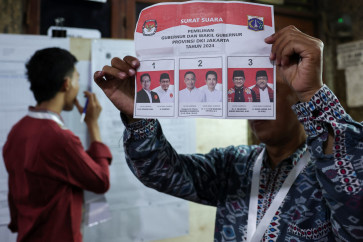Popular Reads
Top Results
Can't find what you're looking for?
View all search resultsPopular Reads
Top Results
Can't find what you're looking for?
View all search resultsInto the soul of Seoul
Ancient: Part of the famous Seoul City Wall with the city in the background
Change text size
Gift Premium Articles
to Anyone
A
span class="caption">Ancient: Part of the famous Seoul City Wall with the city in the background. As many as 118,070 people were mobilized in 1396 to construct the wall envisioned by King Taejo as a barrier against enemy incursion.
A thin layer of ice still covered the narrow trail that led to an area alongside the Hangang River.
The sky was very clear and its deep blue color provided the perfect backdrop for acres and acres of wild brown grass, interspersed with fragile flowers swaying gently as their buds flickered under the embrace of the afternoon sun.
Along the trail was the only thing that spoke of man's presence in this vast marshland ' an old man walking unhurriedly. He hummed a melody that evoked sadness, sometimes almost inaudibly, while he caressed a tiny wooden stick in his hands. One might not understand the words he recited but the melancholic yearning of the tune and his expression was obvious to anybody.
'It was a traditional song of separation and longing,' Nicholas Hong said, before turning his back and pointing at a hill across the marshland.
'That hill used to be the largest landfill in Seoul. The overwhelming stench of garbage used to engulf this area,' he said.
There is no bad odor hovering in the air any longer. The Seoul Metropolitan Government (SMG) closed the landfill in 1993, before spending three years and US$117 million to rehabilitate the site and rejuvenate its ecosystem. Another $78 million was spent on constructing eco-friendly parks.
The marshland opposite the hill is part of Nanji Hangang Park, one of 12 parks that dot the banks of Hangang river.
'South Koreans have now realized that the development, the industry-oriented one, has had many negative effects. We are now trying to reverse them; trying to return to the old way that respects nature, trying to regain our soul,' he said.
Nicholas is an executive at Li TV, a television station that partnered with the SMG to introduce a different face of Seoul to visiting guests. The capital city drew more than 10 million visitors in 2012, a number that is expected to increase significantly due to the successful expansion of Korean Wave ' a term that refers to the spread of South Korean popular culture ' across the globe.
Called the Seoul Storytelling Tour, the new program targets repeat visitors and aims to showcase a Korea that is both historically rich and contemporarily fresh. It comprises four courses ' the Hangang River story course, Sejong Street course, Seoul City Wall course, and Dongdaemun course.



Around the city: (up to bottom) Tourists savor the landscape of dynamic Seoul from a boat that sails along the Hangang River. Architecture-lovers will fall in love with a large number of intricately decorated, brightly painted, and well-preserved palaces and traditional buildings. An old man walks on the circular wooden plank at Nanji Hangang Park. A man passes below Gwangtonggyo stone bridge in downtown Seoul.
Except for the Hangang River course, in which visitors take a trip on a slow moving boat, all the other courses can be taken on foot.
Each course takes visitors deeper into the intricate social, historical, and cultural tapestry that formed the foundation of modern South Korea, which is famous across the world as a strong nation with first-rate work ethic and powerful industry that churns out world-class products.
A slow walk along Sejong-daero, a 100-meter-wide street, revealed the person that played a critical role in making South Koreans a group of tough, determined and proud people. An imposing statue of a gentle king seated on his throne greeted the visitors.
It was the statue of King Sejong the Great (1397-1450), the fourth ruler of the Joseon Dynasty and without a doubt the most beloved king in the history of Korea. He was a benevolent ruler, an avid scientist, a cunning military strategist and an accomplished inventor who created, among other things, one of the earliest versions of a rocket launcher, using arrows as missiles. He was also responsible for refining Korean musical instruments and he generously supported Korean scholars who later invented the sun dial, rain gauge, water clock, and astronomical map.
His long-lasting and arguably greatest contribution was Hangeul, the Korean alphabet. He invented the alphabet to enable common people to express themselves. The prevailing alphabet in the Korean royal court at that time was Chinese. The introduction of the much simpler Hangeul gradually brought Korea out of the shadow of the Chinese empire and eventually became an iconic symbol of Korea's independent spirit and cultural identity.
An underground museum beneath the statue is the perfect place to learn about King Sejong. It also offers copies of the king's poems in Hangeul, which certainly has more value as a memento than a smartphone produced by one of the country's global conglomerates, locally known as chaebols.
Yet, the strength of the courses lies not in the majestic gates, stately palaces, or an impressive defensive wall that visitors can see, but in the intriguing lore that makes all those buildings come alive and dance before visitors' eyes. This task falls to a group of 250 special volunteers, mostly retired individuals who are all natives of the respective areas of the courses.
One of them was Ho Park, which he jovially translated as Mr. Pumpkin. Happily sipping a cup of makgeolli (sweet, milky alcoholic beverage made from rice) at a crowded noodle stall in the Dongdaemun area, Mr. Pumpkin enlightened his audience with a historically accurate story of the one-time fabric market that has become Seoul's biggest shopping area, peppering the account with anecdotes and jokes.
'In ancient times there were a lot of Confucian shrines in this area. There were a lot of bones left over from the meat offered in the shrine and consumed by the pilgrims. Many noodle soup sellers then moved to this place to take advantage of the large, free supply of bones, an essential ingredient for their soup. That's why there are many noodle stalls in this area,' said the former executive of fashion brand Hermes.
That's a piece of information that you couldn't find in a regular travel book. Moreover, the presence of Mr. Pumpkin provided the program with not only a human touch but also a real, visible connection to Seoul's historical past and its current condition.
Mr. Pumpkin put on his gloves and shouldered his backpack before heading for the door. Outside the noodle stall, he and his entourage passed a parked 600 cc BMW scooter, a reminder of how modern and connected Seoul was. Yet the group ignored the shiny machine and marched on behind the man, who would give them stories of times long gone.
' Photos by I Wayan Juniarta











